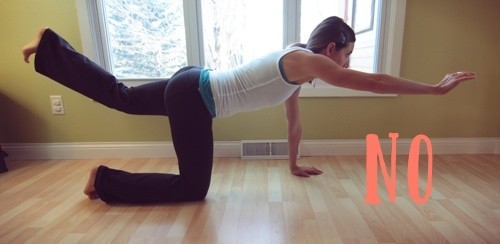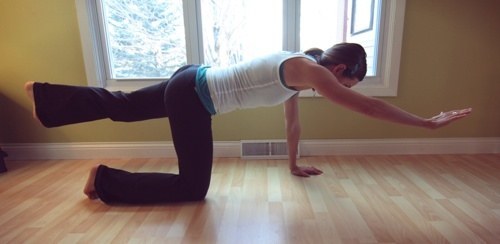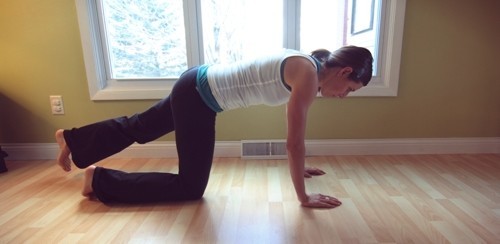Core Stabilization
Core stabilization, trunk stabilization, pelvic stabilization. What does it mean? Are you doing lots of “core stabilization” exercises? If so, you are not alone. It is a big deal these days. They are highly recommended for preventing back pain. But in order for them to work properly, we need to fine-tune our approach.
Holding the trunk stable
Trunk stabilization means holding the trunk stable as you move the limbs. The stability comes mostly from little muscles near the spine, the transversus abdominus in the front and the pelvic floor muscles. We cannot work these muscles out with weight machines. They have more to do with our brains. It is the timing and activation of these muscles that keep the trunk stable.

In this example of arm and leg reach, notice that my back is in a slightly arched (extended) position. The trunk is not stabilized. When I arch the back here, the muscles of the front body are placed in a lengthened position while the lower back muscles are relatively shortened. The long back muscles are the ones contracting, while the abs are not working much. This is not what we want.
How can we focus the work into the abdominals with this exercise?
Improve your timing
In this pose, I have timed things differently.

I have taken a breath, and then on the exhale, I have contracted my pelvic floor muscles and transversus abdominus. As I reach out with my limbs, I continue to exhale and squeeze the pelvic floor (mula bandha).
In this variation, I can feel my abdominals pulling inward. I stop the range of motion when I feel the lumbar paraspinal muscles tightening more than my abdominals. This is pelvic neutral, and it is where the core activates best. This range is different for each person.
If I find that I cannot keep my core activated when lifting both arm and leg, I might modify the pose like this.

If you want the maximum stabilization benefit from this pose, you will notice some shakiness when you get to the right position. This simply means your stabilizer muscles are being challenged. Yay! And your back should feel better. : )
Stay tuned for more about the connection between the pelvic floor and transversus abdominus.


Comments